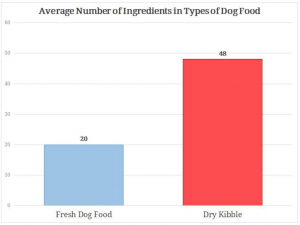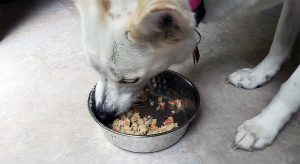This article was written by Derek Gaughan. You can read more of his work at woofwhiskers.com
As someone who writes and researches all kinds of dog foods, I’ve been hearing a lot of chatter from dog owners looking to switch away from traditional kibble. For those that are making the jump to fresh dog food delivery services, there has been one resounding reason I’ve heard over and over again – it’s all about the ingredients list.
When we recently did our analysis of over 1,200 dry dog foods we came up with a lot of interesting findings. When we compare the average dry dog food to new fresh dog food recipes, it’s readily apparent what dog owners are loving about fresh dog food in comparison.
For starters, fresh dog foods have an average of 20 ingredients in their recipes whereas dry kibble averages 48! When dog owners see an ingredient list that looks like it’s a page long and you need a PhD to decipher what the chemical additives are within it, they lose confidence in the dog food.

While 48 may be the average, some dry dog foods take it to the extremes of 70-90 ingredients listed!
Why the long ingredient list?
We’ve seen that dry kibble dog foods have over twice the ingredients as fresh dog food, but why is that the case? And what does it say about fresh vs kibble? It turns out there are two main reasons why dry dog foods have so many more ingredients.
Preservatives
A big reason why dry dog foods have so many more ingredients is they contain a lot of preservatives to prevent them from spoiling. According to one prominent dog food manufacturer, kibble can remain unspoiled for 16 months if not opened!
Can you think of many foods you would eat after letting it sit on your shelf at room temperature for 16 months? If so, is it a healthy food that you would eat as your entire diet for your entire life? Not likely!
Since fresh dog food delivery meals are prepared on demand at least once a week, often fed within a few weeks of receiving, and are refrigerated or frozen in the meantime, fresh dog food doesn’t require loads of preservatives to prevent spoiling. The fresh dog food way of feeding matches much more closely with how humans feed themselves and how a dog would naturally eat before they became modern pets.
Supplements
While even fresh dog foods often have to include some vitamin supplements in order to meet AAFCO standards for meeting all of a dog’s nutrient requirements, you’ll notice that dry kibble contains many more supplements and additives to meet those standards.
For example, I found that 84% of dry dog foods had choline chloride as an added ingredient in order to supplement Vitamin B. Another indicator that dry kibble doesn’t use enough meat or protein sources in their kibble is the fact that many have to supplement amino acids into their recipes. Amino acids are the building blocks that mammals use to make proteins for the body. You’ll find that fresh dog food recipes use enough protein sources that they don’t need to supplement amino acids such as DL-Methionine, L-Carnitine, and L-Lysine yet those are common in dry dog foods.
Dare to Compare Your Ingredient List
If you’ve haven’t thought much about the ingredient list on what you’re feeding your dog, now is a great time to look it over and see if you can do better. We reviewed The Farmer’s Dog recipes and listed many of their ingredient lists and you can see for yourself how much cleaner and natural fresh dog food is compared to dry kibble.
This is also why one of our chief testers, Sasha, continues to eat fresh.










